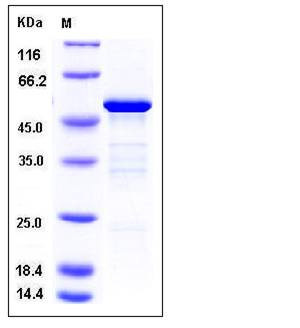Mouse 14-3-3 epsilon / YWHAE Protein (GST Tag)
AU019196
- 100ug (NPP3168) Please inquiry
| Catalog Number | P50691-M09E |
|---|---|
| Organism Species | Mouse |
| Host | E. coli |
| Synonyms | AU019196 |
| Molecular Weight | The recombinant mouse YWHAE/GST chimera consists of 487 amino acids and has a predicted molecular mass of 56.1 kDa. It migrates as an approxiamtely 48 kDa band in SDS-PAGE under reducing conditions. |
| predicted N | Met |
| SDS-PAGE |  |
| Purity | > 90 % as determined by SDS-PAGE |
| Protein Construction | A DNA sequence encoding the mouse YWHAE (P62259) (Met 1-Gln 255) was fused with the GST tag at the N-terminus. |
| Bio-activity | |
| Research Area | Cancer |Signal transduction |Signaling Pathway |Representative pathway |Apoptosis Signaling pathway |Apoptosis Adaptor Proteins | |
| Formulation | Lyophilized from sterile 50mM Tris, 2mM GSH, 1mM DTT, pH 8.2 1. Normally 5 % - 8 % trehalose and mannitol are added as protectants before lyophilization. Specific concentrations are included in the hardcopy of COA. |
| Background | YWHAE, also known as 14-3-3 epsilon, mediate signal transduction by binding to phosphoserine-containing proteins. 14-3-3 epsilon / YWHAE is a member of the 14-3-3 proteins family. 14-3-3 proteins are a group of highly conserved proteins that are involved in many vital cellular processes such as metabolism, protein trafficking, signal transduction, apoptosis and cell cycle regulation. 14-3-3 proteins are mainly localized in the synapses and neuronal cytoplasm, and seven isoforms have been identified in mammals. This family of proteins was initially identified as adaptor proteins which bind to phosphoserine-containing motifs. Binding motifs and potential functions of 14-3-3 proteins are now recognized to have a wide range of functional relevance. 14-3-3 epsilon / YWHAE is found in both plants and mammals, and this protein is 100% identical to the mouse ortholog. YWHAE interacts with CDC25 phosphatases, RAF1 and IRS1 proteins, suggesting its role in diverse biochemical activities related to signal transduction, such as cell division and regulation of insulin sensitivity. It has also been implicated in the pathogenesis of small cell lung cancer. 14-3-3 epsilon / YWHAE is implicated in the regulation of a large spectrum of both general and specialized signaling pathways. 14-3-3 epsilon / YWHAE Binds to a large number of partners, usually by recognition of a phosphoserine or phosphothreonine motif. This Binding generally results in the modulation of the activity of the binding partner. |
| Reference |
